A Detailed Review of Australian Tax Concessions for Small Businesses
VerifiedAdded on 2023/06/11
|9
|2464
|84
Essay
AI Summary
This essay provides a comprehensive overview of the various tax concessions available to small business entities (SBEs) in Australia, as outlined by the Australian Tax Office (ATO) and governed by legislation such as the Income Tax Assessment Act 1997 (ITAA97). It covers key concessions including income tax offsets, Capital Gains Tax (CGT) relief (including 15-year asset exemptions and 50% tax relief), simplified depreciation rules, inventory accounting concessions, deductions on prepayment expenses, cash basis accounting for income tax and GST, and input tax credits on GST expenditures. The essay emphasizes how these concessions aim to reduce the tax burden on SBEs, improve their cash flow management, and support their growth and sustainability within the Australian economy. Examples are provided to illustrate the practical application of these concessions, highlighting their significance in minimizing tax liabilities and promoting operational efficiency for small businesses.
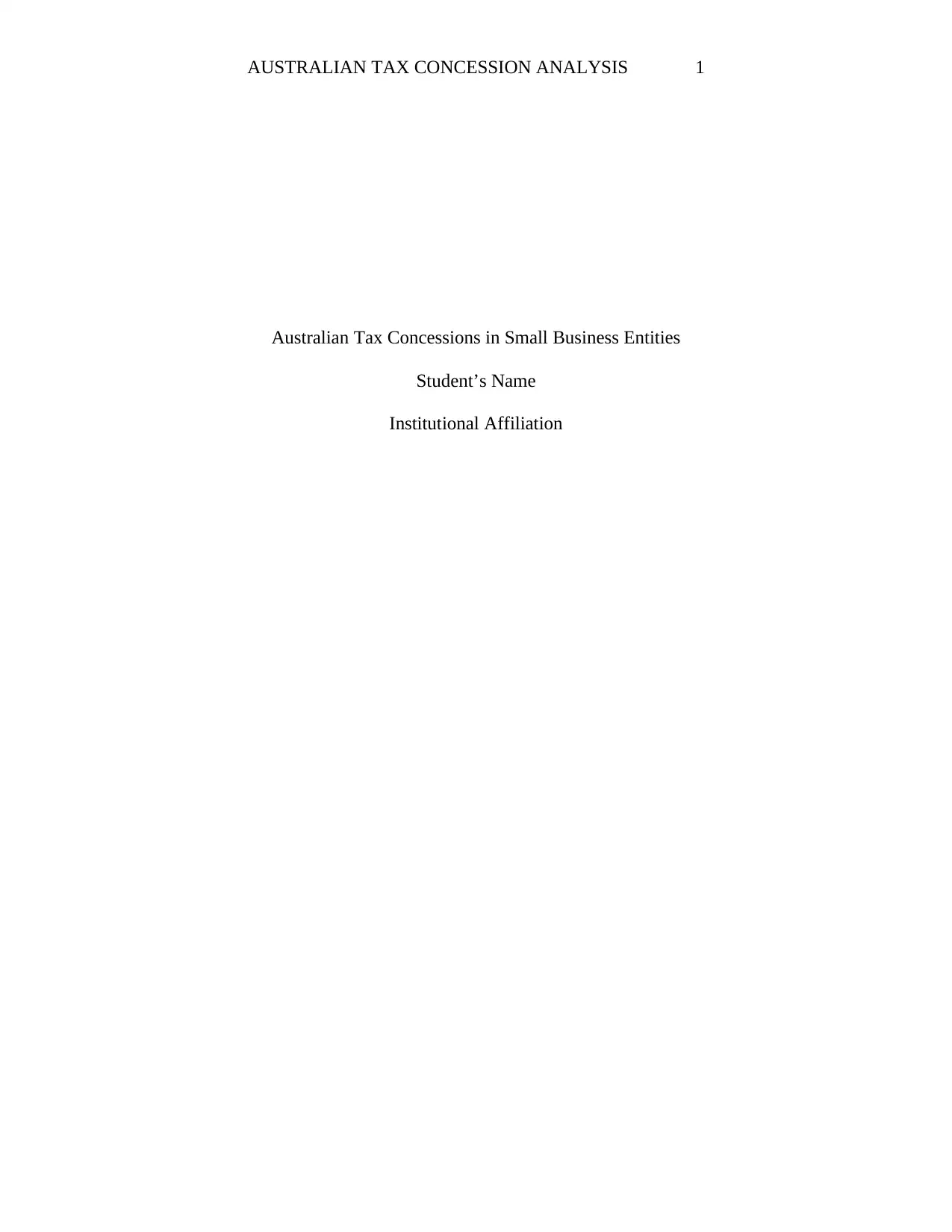
AUSTRALIAN TAX CONCESSION ANALYSIS 1
Australian Tax Concessions in Small Business Entities
Student’s Name
Institutional Affiliation
Australian Tax Concessions in Small Business Entities
Student’s Name
Institutional Affiliation
Paraphrase This Document
Need a fresh take? Get an instant paraphrase of this document with our AI Paraphraser
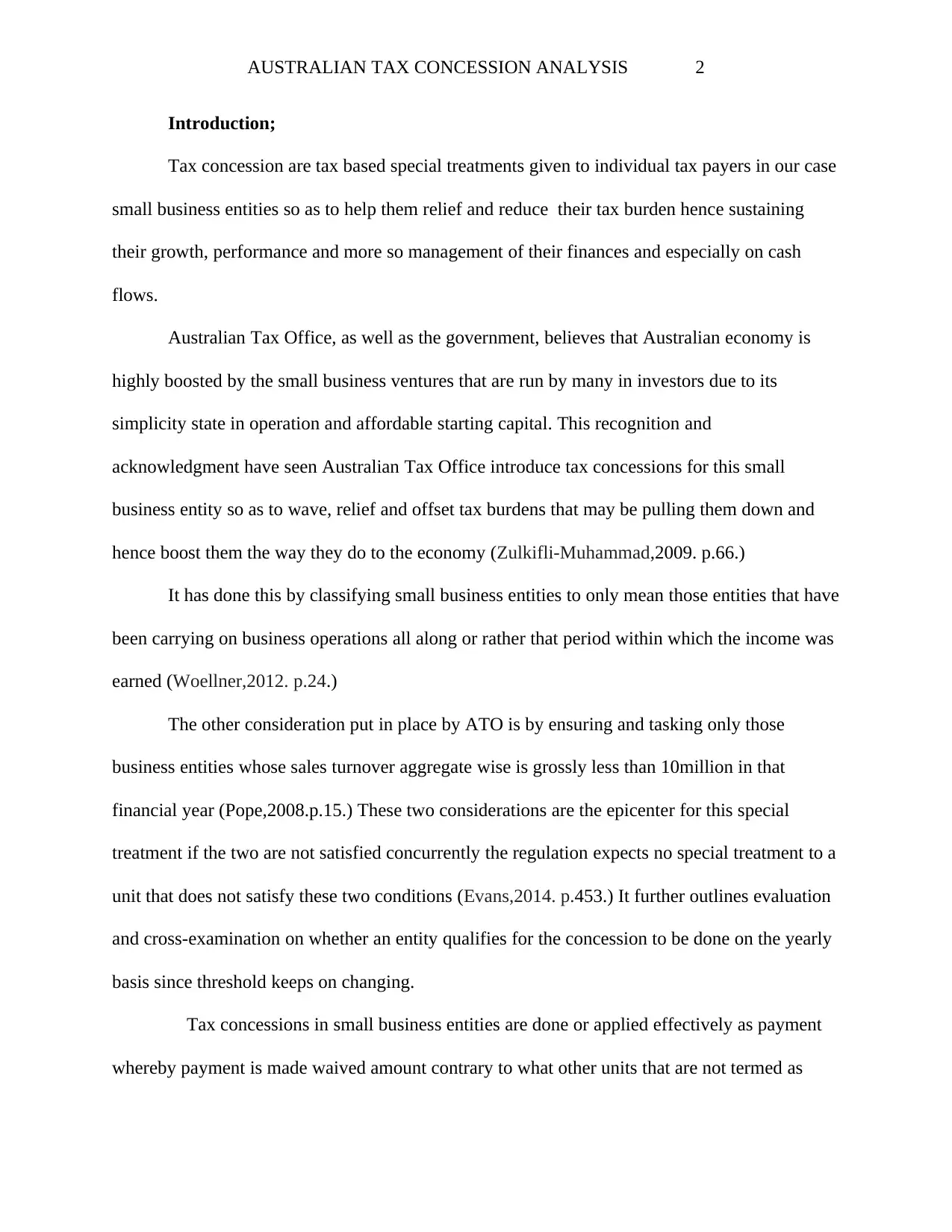
AUSTRALIAN TAX CONCESSION ANALYSIS 2
Introduction;
Tax concession are tax based special treatments given to individual tax payers in our case
small business entities so as to help them relief and reduce their tax burden hence sustaining
their growth, performance and more so management of their finances and especially on cash
flows.
Australian Tax Office, as well as the government, believes that Australian economy is
highly boosted by the small business ventures that are run by many in investors due to its
simplicity state in operation and affordable starting capital. This recognition and
acknowledgment have seen Australian Tax Office introduce tax concessions for this small
business entity so as to wave, relief and offset tax burdens that may be pulling them down and
hence boost them the way they do to the economy (Zulkifli-Muhammad,2009. p.66.)
It has done this by classifying small business entities to only mean those entities that have
been carrying on business operations all along or rather that period within which the income was
earned (Woellner,2012. p.24.)
The other consideration put in place by ATO is by ensuring and tasking only those
business entities whose sales turnover aggregate wise is grossly less than 10million in that
financial year (Pope,2008.p.15.) These two considerations are the epicenter for this special
treatment if the two are not satisfied concurrently the regulation expects no special treatment to a
unit that does not satisfy these two conditions (Evans,2014. p.453.) It further outlines evaluation
and cross-examination on whether an entity qualifies for the concession to be done on the yearly
basis since threshold keeps on changing.
Tax concessions in small business entities are done or applied effectively as payment
whereby payment is made waived amount contrary to what other units that are not termed as
Introduction;
Tax concession are tax based special treatments given to individual tax payers in our case
small business entities so as to help them relief and reduce their tax burden hence sustaining
their growth, performance and more so management of their finances and especially on cash
flows.
Australian Tax Office, as well as the government, believes that Australian economy is
highly boosted by the small business ventures that are run by many in investors due to its
simplicity state in operation and affordable starting capital. This recognition and
acknowledgment have seen Australian Tax Office introduce tax concessions for this small
business entity so as to wave, relief and offset tax burdens that may be pulling them down and
hence boost them the way they do to the economy (Zulkifli-Muhammad,2009. p.66.)
It has done this by classifying small business entities to only mean those entities that have
been carrying on business operations all along or rather that period within which the income was
earned (Woellner,2012. p.24.)
The other consideration put in place by ATO is by ensuring and tasking only those
business entities whose sales turnover aggregate wise is grossly less than 10million in that
financial year (Pope,2008.p.15.) These two considerations are the epicenter for this special
treatment if the two are not satisfied concurrently the regulation expects no special treatment to a
unit that does not satisfy these two conditions (Evans,2014. p.453.) It further outlines evaluation
and cross-examination on whether an entity qualifies for the concession to be done on the yearly
basis since threshold keeps on changing.
Tax concessions in small business entities are done or applied effectively as payment
whereby payment is made waived amount contrary to what other units that are not termed as
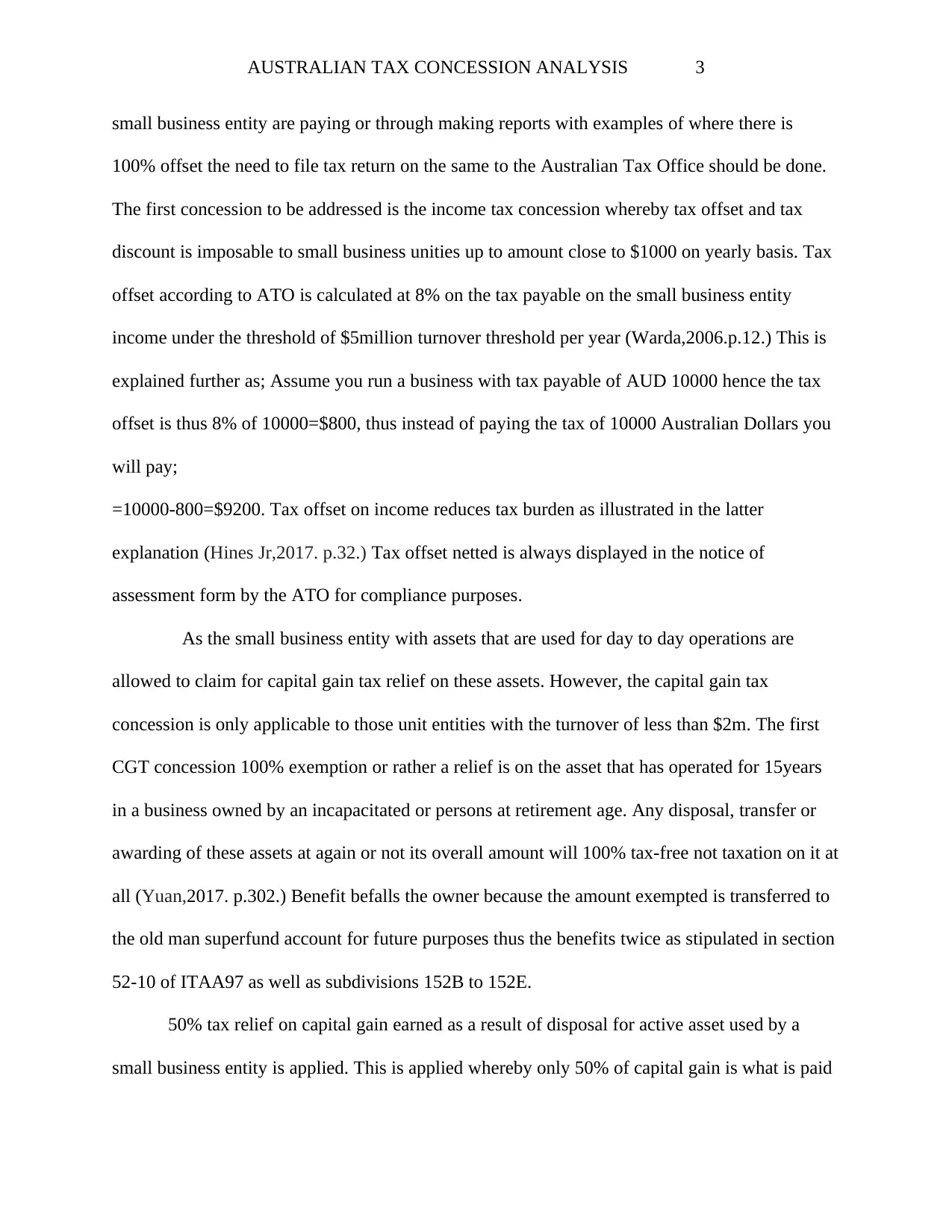
AUSTRALIAN TAX CONCESSION ANALYSIS 3
small business entity are paying or through making reports with examples of where there is
100% offset the need to file tax return on the same to the Australian Tax Office should be done.
The first concession to be addressed is the income tax concession whereby tax offset and tax
discount is imposable to small business unities up to amount close to $1000 on yearly basis. Tax
offset according to ATO is calculated at 8% on the tax payable on the small business entity
income under the threshold of $5million turnover threshold per year (Warda,2006.p.12.) This is
explained further as; Assume you run a business with tax payable of AUD 10000 hence the tax
offset is thus 8% of 10000=$800, thus instead of paying the tax of 10000 Australian Dollars you
will pay;
=10000-800=$9200. Tax offset on income reduces tax burden as illustrated in the latter
explanation (Hines Jr,2017. p.32.) Tax offset netted is always displayed in the notice of
assessment form by the ATO for compliance purposes.
As the small business entity with assets that are used for day to day operations are
allowed to claim for capital gain tax relief on these assets. However, the capital gain tax
concession is only applicable to those unit entities with the turnover of less than $2m. The first
CGT concession 100% exemption or rather a relief is on the asset that has operated for 15years
in a business owned by an incapacitated or persons at retirement age. Any disposal, transfer or
awarding of these assets at again or not its overall amount will 100% tax-free not taxation on it at
all (Yuan,2017. p.302.) Benefit befalls the owner because the amount exempted is transferred to
the old man superfund account for future purposes thus the benefits twice as stipulated in section
52-10 of ITAA97 as well as subdivisions 152B to 152E.
50% tax relief on capital gain earned as a result of disposal for active asset used by a
small business entity is applied. This is applied whereby only 50% of capital gain is what is paid
small business entity are paying or through making reports with examples of where there is
100% offset the need to file tax return on the same to the Australian Tax Office should be done.
The first concession to be addressed is the income tax concession whereby tax offset and tax
discount is imposable to small business unities up to amount close to $1000 on yearly basis. Tax
offset according to ATO is calculated at 8% on the tax payable on the small business entity
income under the threshold of $5million turnover threshold per year (Warda,2006.p.12.) This is
explained further as; Assume you run a business with tax payable of AUD 10000 hence the tax
offset is thus 8% of 10000=$800, thus instead of paying the tax of 10000 Australian Dollars you
will pay;
=10000-800=$9200. Tax offset on income reduces tax burden as illustrated in the latter
explanation (Hines Jr,2017. p.32.) Tax offset netted is always displayed in the notice of
assessment form by the ATO for compliance purposes.
As the small business entity with assets that are used for day to day operations are
allowed to claim for capital gain tax relief on these assets. However, the capital gain tax
concession is only applicable to those unit entities with the turnover of less than $2m. The first
CGT concession 100% exemption or rather a relief is on the asset that has operated for 15years
in a business owned by an incapacitated or persons at retirement age. Any disposal, transfer or
awarding of these assets at again or not its overall amount will 100% tax-free not taxation on it at
all (Yuan,2017. p.302.) Benefit befalls the owner because the amount exempted is transferred to
the old man superfund account for future purposes thus the benefits twice as stipulated in section
52-10 of ITAA97 as well as subdivisions 152B to 152E.
50% tax relief on capital gain earned as a result of disposal for active asset used by a
small business entity is applied. This is applied whereby only 50% of capital gain is what is paid
⊘ This is a preview!⊘
Do you want full access?
Subscribe today to unlock all pages.

Trusted by 1+ million students worldwide
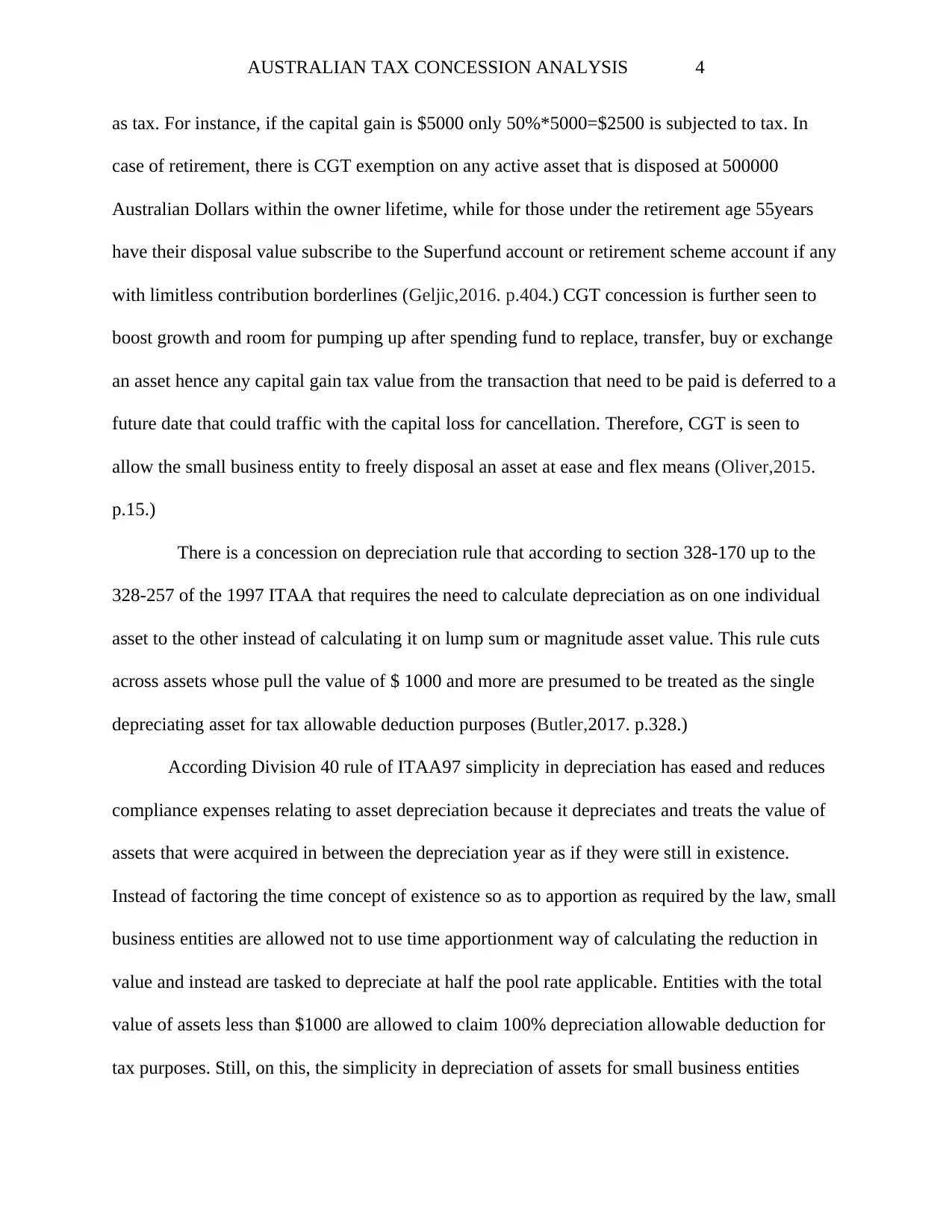
AUSTRALIAN TAX CONCESSION ANALYSIS 4
as tax. For instance, if the capital gain is $5000 only 50%*5000=$2500 is subjected to tax. In
case of retirement, there is CGT exemption on any active asset that is disposed at 500000
Australian Dollars within the owner lifetime, while for those under the retirement age 55years
have their disposal value subscribe to the Superfund account or retirement scheme account if any
with limitless contribution borderlines (Geljic,2016. p.404.) CGT concession is further seen to
boost growth and room for pumping up after spending fund to replace, transfer, buy or exchange
an asset hence any capital gain tax value from the transaction that need to be paid is deferred to a
future date that could traffic with the capital loss for cancellation. Therefore, CGT is seen to
allow the small business entity to freely disposal an asset at ease and flex means (Oliver,2015.
p.15.)
There is a concession on depreciation rule that according to section 328-170 up to the
328-257 of the 1997 ITAA that requires the need to calculate depreciation as on one individual
asset to the other instead of calculating it on lump sum or magnitude asset value. This rule cuts
across assets whose pull the value of $ 1000 and more are presumed to be treated as the single
depreciating asset for tax allowable deduction purposes (Butler,2017. p.328.)
According Division 40 rule of ITAA97 simplicity in depreciation has eased and reduces
compliance expenses relating to asset depreciation because it depreciates and treats the value of
assets that were acquired in between the depreciation year as if they were still in existence.
Instead of factoring the time concept of existence so as to apportion as required by the law, small
business entities are allowed not to use time apportionment way of calculating the reduction in
value and instead are tasked to depreciate at half the pool rate applicable. Entities with the total
value of assets less than $1000 are allowed to claim 100% depreciation allowable deduction for
tax purposes. Still, on this, the simplicity in depreciation of assets for small business entities
as tax. For instance, if the capital gain is $5000 only 50%*5000=$2500 is subjected to tax. In
case of retirement, there is CGT exemption on any active asset that is disposed at 500000
Australian Dollars within the owner lifetime, while for those under the retirement age 55years
have their disposal value subscribe to the Superfund account or retirement scheme account if any
with limitless contribution borderlines (Geljic,2016. p.404.) CGT concession is further seen to
boost growth and room for pumping up after spending fund to replace, transfer, buy or exchange
an asset hence any capital gain tax value from the transaction that need to be paid is deferred to a
future date that could traffic with the capital loss for cancellation. Therefore, CGT is seen to
allow the small business entity to freely disposal an asset at ease and flex means (Oliver,2015.
p.15.)
There is a concession on depreciation rule that according to section 328-170 up to the
328-257 of the 1997 ITAA that requires the need to calculate depreciation as on one individual
asset to the other instead of calculating it on lump sum or magnitude asset value. This rule cuts
across assets whose pull the value of $ 1000 and more are presumed to be treated as the single
depreciating asset for tax allowable deduction purposes (Butler,2017. p.328.)
According Division 40 rule of ITAA97 simplicity in depreciation has eased and reduces
compliance expenses relating to asset depreciation because it depreciates and treats the value of
assets that were acquired in between the depreciation year as if they were still in existence.
Instead of factoring the time concept of existence so as to apportion as required by the law, small
business entities are allowed not to use time apportionment way of calculating the reduction in
value and instead are tasked to depreciate at half the pool rate applicable. Entities with the total
value of assets less than $1000 are allowed to claim 100% depreciation allowable deduction for
tax purposes. Still, on this, the simplicity in depreciation of assets for small business entities
Paraphrase This Document
Need a fresh take? Get an instant paraphrase of this document with our AI Paraphraser
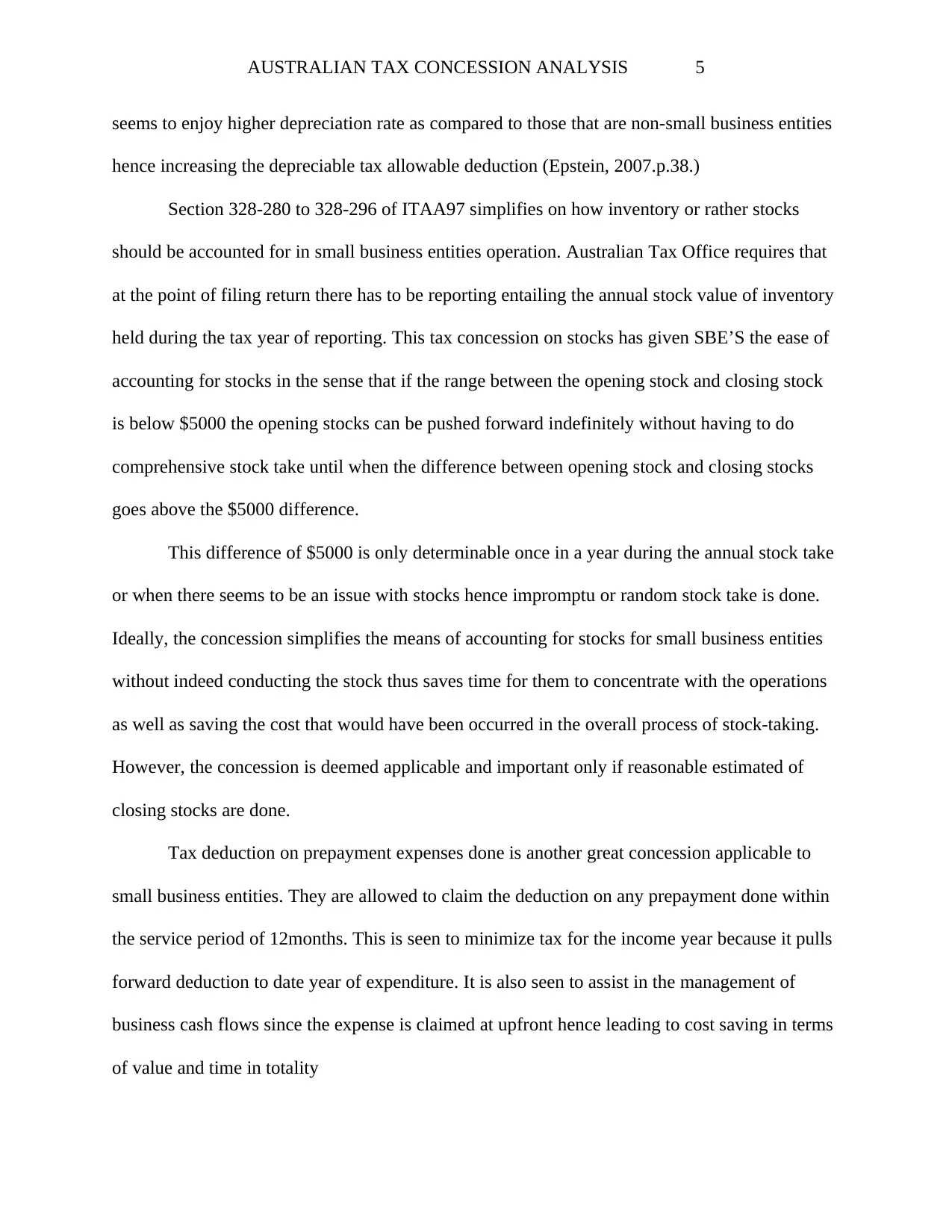
AUSTRALIAN TAX CONCESSION ANALYSIS 5
seems to enjoy higher depreciation rate as compared to those that are non-small business entities
hence increasing the depreciable tax allowable deduction (Epstein, 2007.p.38.)
Section 328-280 to 328-296 of ITAA97 simplifies on how inventory or rather stocks
should be accounted for in small business entities operation. Australian Tax Office requires that
at the point of filing return there has to be reporting entailing the annual stock value of inventory
held during the tax year of reporting. This tax concession on stocks has given SBE’S the ease of
accounting for stocks in the sense that if the range between the opening stock and closing stock
is below $5000 the opening stocks can be pushed forward indefinitely without having to do
comprehensive stock take until when the difference between opening stock and closing stocks
goes above the $5000 difference.
This difference of $5000 is only determinable once in a year during the annual stock take
or when there seems to be an issue with stocks hence impromptu or random stock take is done.
Ideally, the concession simplifies the means of accounting for stocks for small business entities
without indeed conducting the stock thus saves time for them to concentrate with the operations
as well as saving the cost that would have been occurred in the overall process of stock-taking.
However, the concession is deemed applicable and important only if reasonable estimated of
closing stocks are done.
Tax deduction on prepayment expenses done is another great concession applicable to
small business entities. They are allowed to claim the deduction on any prepayment done within
the service period of 12months. This is seen to minimize tax for the income year because it pulls
forward deduction to date year of expenditure. It is also seen to assist in the management of
business cash flows since the expense is claimed at upfront hence leading to cost saving in terms
of value and time in totality
seems to enjoy higher depreciation rate as compared to those that are non-small business entities
hence increasing the depreciable tax allowable deduction (Epstein, 2007.p.38.)
Section 328-280 to 328-296 of ITAA97 simplifies on how inventory or rather stocks
should be accounted for in small business entities operation. Australian Tax Office requires that
at the point of filing return there has to be reporting entailing the annual stock value of inventory
held during the tax year of reporting. This tax concession on stocks has given SBE’S the ease of
accounting for stocks in the sense that if the range between the opening stock and closing stock
is below $5000 the opening stocks can be pushed forward indefinitely without having to do
comprehensive stock take until when the difference between opening stock and closing stocks
goes above the $5000 difference.
This difference of $5000 is only determinable once in a year during the annual stock take
or when there seems to be an issue with stocks hence impromptu or random stock take is done.
Ideally, the concession simplifies the means of accounting for stocks for small business entities
without indeed conducting the stock thus saves time for them to concentrate with the operations
as well as saving the cost that would have been occurred in the overall process of stock-taking.
However, the concession is deemed applicable and important only if reasonable estimated of
closing stocks are done.
Tax deduction on prepayment expenses done is another great concession applicable to
small business entities. They are allowed to claim the deduction on any prepayment done within
the service period of 12months. This is seen to minimize tax for the income year because it pulls
forward deduction to date year of expenditure. It is also seen to assist in the management of
business cash flows since the expense is claimed at upfront hence leading to cost saving in terms
of value and time in totality
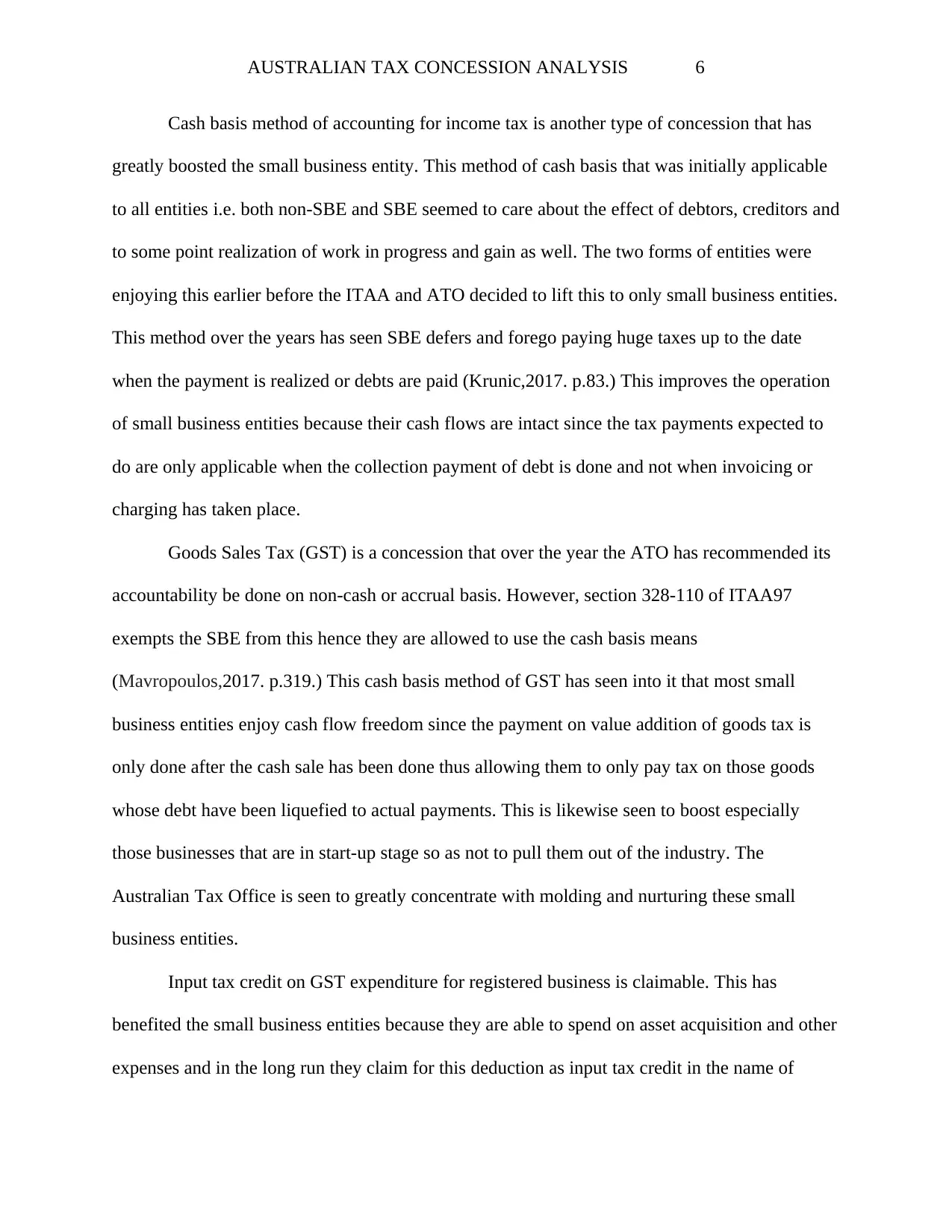
AUSTRALIAN TAX CONCESSION ANALYSIS 6
Cash basis method of accounting for income tax is another type of concession that has
greatly boosted the small business entity. This method of cash basis that was initially applicable
to all entities i.e. both non-SBE and SBE seemed to care about the effect of debtors, creditors and
to some point realization of work in progress and gain as well. The two forms of entities were
enjoying this earlier before the ITAA and ATO decided to lift this to only small business entities.
This method over the years has seen SBE defers and forego paying huge taxes up to the date
when the payment is realized or debts are paid (Krunic,2017. p.83.) This improves the operation
of small business entities because their cash flows are intact since the tax payments expected to
do are only applicable when the collection payment of debt is done and not when invoicing or
charging has taken place.
Goods Sales Tax (GST) is a concession that over the year the ATO has recommended its
accountability be done on non-cash or accrual basis. However, section 328-110 of ITAA97
exempts the SBE from this hence they are allowed to use the cash basis means
(Mavropoulos,2017. p.319.) This cash basis method of GST has seen into it that most small
business entities enjoy cash flow freedom since the payment on value addition of goods tax is
only done after the cash sale has been done thus allowing them to only pay tax on those goods
whose debt have been liquefied to actual payments. This is likewise seen to boost especially
those businesses that are in start-up stage so as not to pull them out of the industry. The
Australian Tax Office is seen to greatly concentrate with molding and nurturing these small
business entities.
Input tax credit on GST expenditure for registered business is claimable. This has
benefited the small business entities because they are able to spend on asset acquisition and other
expenses and in the long run they claim for this deduction as input tax credit in the name of
Cash basis method of accounting for income tax is another type of concession that has
greatly boosted the small business entity. This method of cash basis that was initially applicable
to all entities i.e. both non-SBE and SBE seemed to care about the effect of debtors, creditors and
to some point realization of work in progress and gain as well. The two forms of entities were
enjoying this earlier before the ITAA and ATO decided to lift this to only small business entities.
This method over the years has seen SBE defers and forego paying huge taxes up to the date
when the payment is realized or debts are paid (Krunic,2017. p.83.) This improves the operation
of small business entities because their cash flows are intact since the tax payments expected to
do are only applicable when the collection payment of debt is done and not when invoicing or
charging has taken place.
Goods Sales Tax (GST) is a concession that over the year the ATO has recommended its
accountability be done on non-cash or accrual basis. However, section 328-110 of ITAA97
exempts the SBE from this hence they are allowed to use the cash basis means
(Mavropoulos,2017. p.319.) This cash basis method of GST has seen into it that most small
business entities enjoy cash flow freedom since the payment on value addition of goods tax is
only done after the cash sale has been done thus allowing them to only pay tax on those goods
whose debt have been liquefied to actual payments. This is likewise seen to boost especially
those businesses that are in start-up stage so as not to pull them out of the industry. The
Australian Tax Office is seen to greatly concentrate with molding and nurturing these small
business entities.
Input tax credit on GST expenditure for registered business is claimable. This has
benefited the small business entities because they are able to spend on asset acquisition and other
expenses and in the long run they claim for this deduction as input tax credit in the name of
⊘ This is a preview!⊘
Do you want full access?
Subscribe today to unlock all pages.

Trusted by 1+ million students worldwide
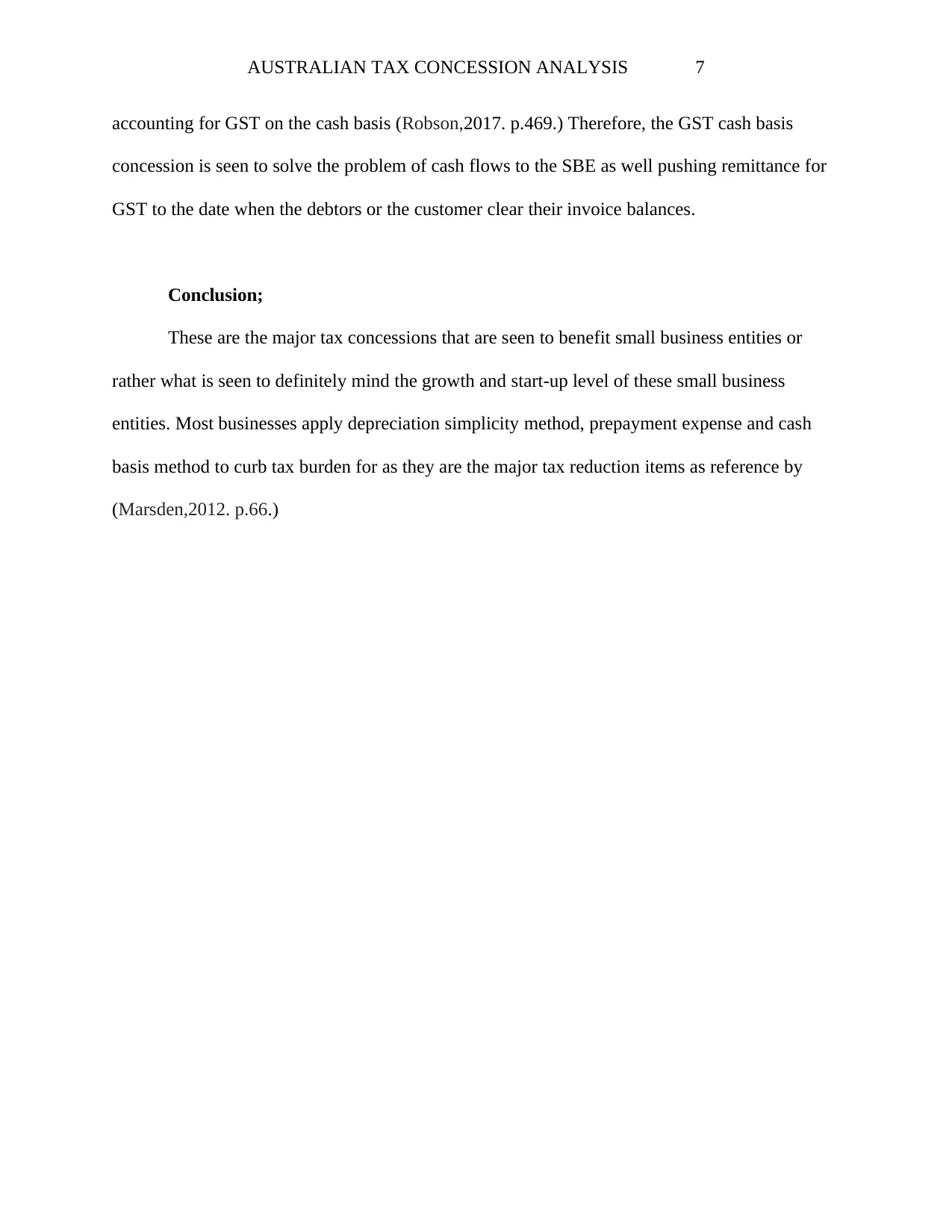
AUSTRALIAN TAX CONCESSION ANALYSIS 7
accounting for GST on the cash basis (Robson,2017. p.469.) Therefore, the GST cash basis
concession is seen to solve the problem of cash flows to the SBE as well pushing remittance for
GST to the date when the debtors or the customer clear their invoice balances.
Conclusion;
These are the major tax concessions that are seen to benefit small business entities or
rather what is seen to definitely mind the growth and start-up level of these small business
entities. Most businesses apply depreciation simplicity method, prepayment expense and cash
basis method to curb tax burden for as they are the major tax reduction items as reference by
(Marsden,2012. p.66.)
accounting for GST on the cash basis (Robson,2017. p.469.) Therefore, the GST cash basis
concession is seen to solve the problem of cash flows to the SBE as well pushing remittance for
GST to the date when the debtors or the customer clear their invoice balances.
Conclusion;
These are the major tax concessions that are seen to benefit small business entities or
rather what is seen to definitely mind the growth and start-up level of these small business
entities. Most businesses apply depreciation simplicity method, prepayment expense and cash
basis method to curb tax burden for as they are the major tax reduction items as reference by
(Marsden,2012. p.66.)
Paraphrase This Document
Need a fresh take? Get an instant paraphrase of this document with our AI Paraphraser
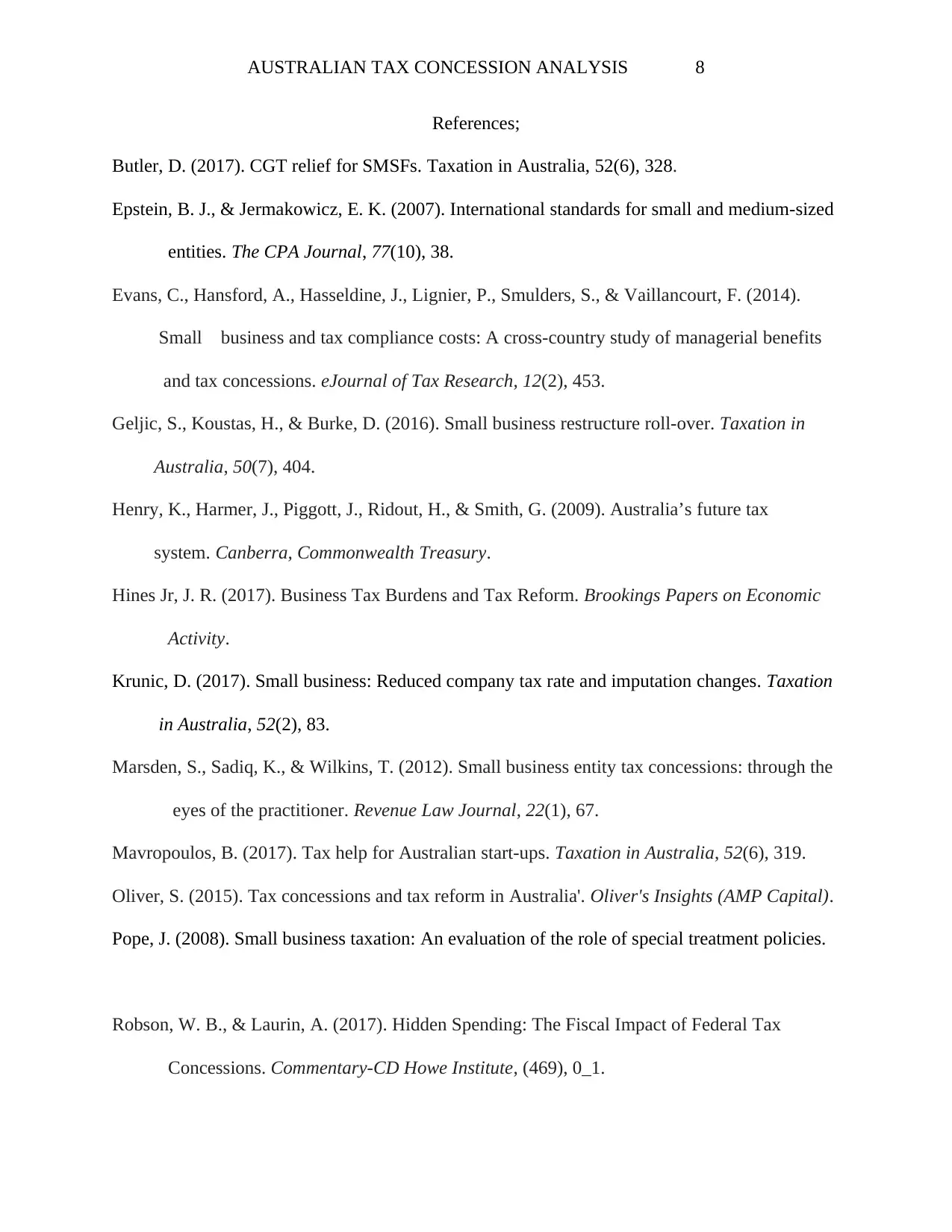
AUSTRALIAN TAX CONCESSION ANALYSIS 8
References;
Butler, D. (2017). CGT relief for SMSFs. Taxation in Australia, 52(6), 328.
Epstein, B. J., & Jermakowicz, E. K. (2007). International standards for small and medium-sized
entities. The CPA Journal, 77(10), 38.
Evans, C., Hansford, A., Hasseldine, J., Lignier, P., Smulders, S., & Vaillancourt, F. (2014).
Small business and tax compliance costs: A cross-country study of managerial benefits
and tax concessions. eJournal of Tax Research, 12(2), 453.
Geljic, S., Koustas, H., & Burke, D. (2016). Small business restructure roll-over. Taxation in
Australia, 50(7), 404.
Henry, K., Harmer, J., Piggott, J., Ridout, H., & Smith, G. (2009). Australia’s future tax
system. Canberra, Commonwealth Treasury.
Hines Jr, J. R. (2017). Business Tax Burdens and Tax Reform. Brookings Papers on Economic
Activity.
Krunic, D. (2017). Small business: Reduced company tax rate and imputation changes. Taxation
in Australia, 52(2), 83.
Marsden, S., Sadiq, K., & Wilkins, T. (2012). Small business entity tax concessions: through the
eyes of the practitioner. Revenue Law Journal, 22(1), 67.
Mavropoulos, B. (2017). Tax help for Australian start-ups. Taxation in Australia, 52(6), 319.
Oliver, S. (2015). Tax concessions and tax reform in Australia'. Oliver's Insights (AMP Capital).
Pope, J. (2008). Small business taxation: An evaluation of the role of special treatment policies.
Robson, W. B., & Laurin, A. (2017). Hidden Spending: The Fiscal Impact of Federal Tax
Concessions. Commentary-CD Howe Institute, (469), 0_1.
References;
Butler, D. (2017). CGT relief for SMSFs. Taxation in Australia, 52(6), 328.
Epstein, B. J., & Jermakowicz, E. K. (2007). International standards for small and medium-sized
entities. The CPA Journal, 77(10), 38.
Evans, C., Hansford, A., Hasseldine, J., Lignier, P., Smulders, S., & Vaillancourt, F. (2014).
Small business and tax compliance costs: A cross-country study of managerial benefits
and tax concessions. eJournal of Tax Research, 12(2), 453.
Geljic, S., Koustas, H., & Burke, D. (2016). Small business restructure roll-over. Taxation in
Australia, 50(7), 404.
Henry, K., Harmer, J., Piggott, J., Ridout, H., & Smith, G. (2009). Australia’s future tax
system. Canberra, Commonwealth Treasury.
Hines Jr, J. R. (2017). Business Tax Burdens and Tax Reform. Brookings Papers on Economic
Activity.
Krunic, D. (2017). Small business: Reduced company tax rate and imputation changes. Taxation
in Australia, 52(2), 83.
Marsden, S., Sadiq, K., & Wilkins, T. (2012). Small business entity tax concessions: through the
eyes of the practitioner. Revenue Law Journal, 22(1), 67.
Mavropoulos, B. (2017). Tax help for Australian start-ups. Taxation in Australia, 52(6), 319.
Oliver, S. (2015). Tax concessions and tax reform in Australia'. Oliver's Insights (AMP Capital).
Pope, J. (2008). Small business taxation: An evaluation of the role of special treatment policies.
Robson, W. B., & Laurin, A. (2017). Hidden Spending: The Fiscal Impact of Federal Tax
Concessions. Commentary-CD Howe Institute, (469), 0_1.
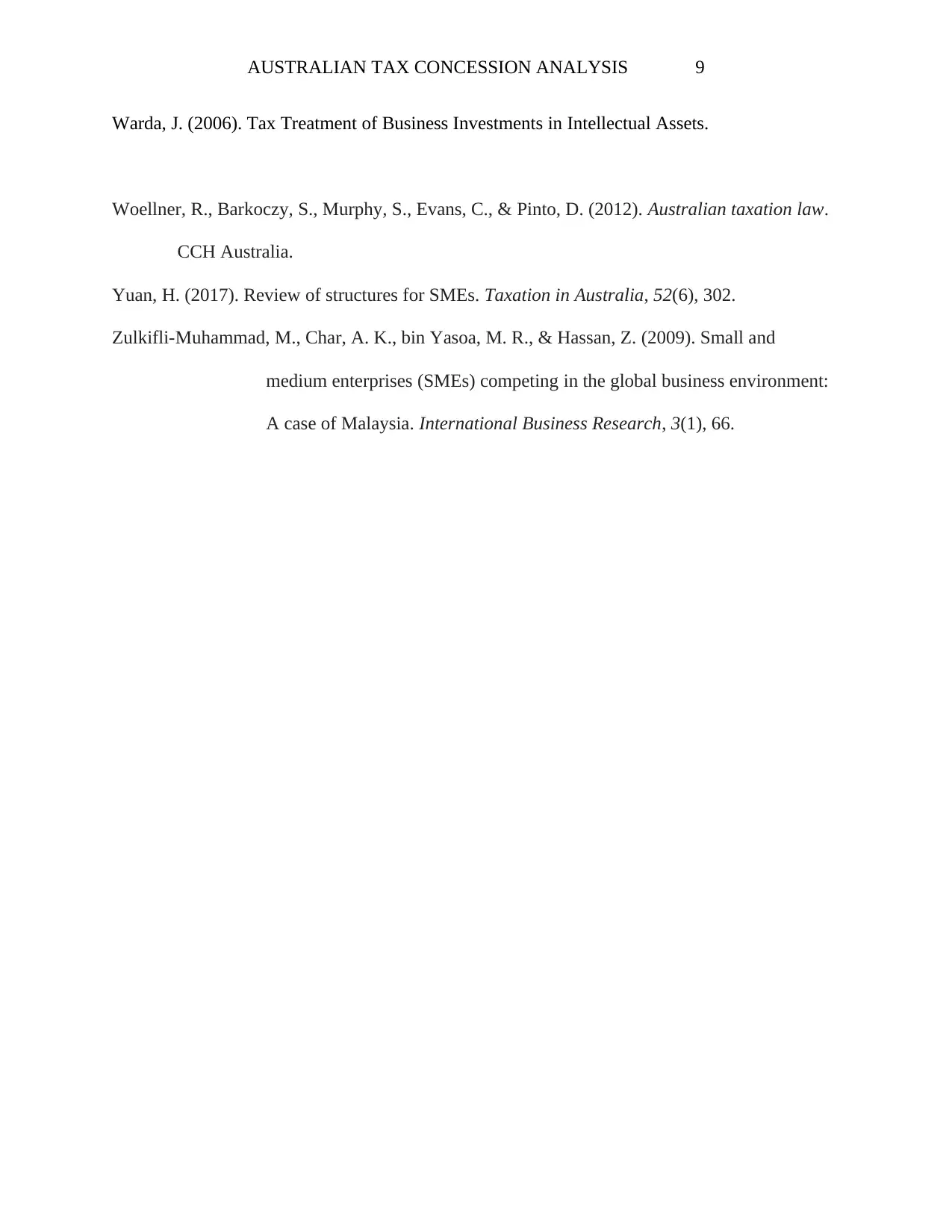
AUSTRALIAN TAX CONCESSION ANALYSIS 9
Warda, J. (2006). Tax Treatment of Business Investments in Intellectual Assets.
Woellner, R., Barkoczy, S., Murphy, S., Evans, C., & Pinto, D. (2012). Australian taxation law.
CCH Australia.
Yuan, H. (2017). Review of structures for SMEs. Taxation in Australia, 52(6), 302.
Zulkifli-Muhammad, M., Char, A. K., bin Yasoa, M. R., & Hassan, Z. (2009). Small and
medium enterprises (SMEs) competing in the global business environment:
A case of Malaysia. International Business Research, 3(1), 66.
Warda, J. (2006). Tax Treatment of Business Investments in Intellectual Assets.
Woellner, R., Barkoczy, S., Murphy, S., Evans, C., & Pinto, D. (2012). Australian taxation law.
CCH Australia.
Yuan, H. (2017). Review of structures for SMEs. Taxation in Australia, 52(6), 302.
Zulkifli-Muhammad, M., Char, A. K., bin Yasoa, M. R., & Hassan, Z. (2009). Small and
medium enterprises (SMEs) competing in the global business environment:
A case of Malaysia. International Business Research, 3(1), 66.
⊘ This is a preview!⊘
Do you want full access?
Subscribe today to unlock all pages.

Trusted by 1+ million students worldwide
1 out of 9
Related Documents
Your All-in-One AI-Powered Toolkit for Academic Success.
+13062052269
info@desklib.com
Available 24*7 on WhatsApp / Email
![[object Object]](/_next/static/media/star-bottom.7253800d.svg)
Unlock your academic potential
Copyright © 2020–2025 A2Z Services. All Rights Reserved. Developed and managed by ZUCOL.





